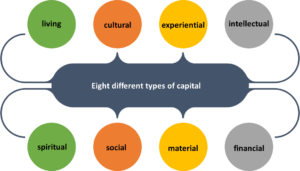Regenerative Economy
-
Module 01: Introduction1.1 Lesson-1: Interested in Regeneration?
-
1.2 Lesson-2: What is Regenerative Economy?
-
1.3 Lesson-3: Principles of Regenerative Economy9 Topics
-
1.3.1 Principle 1: Maintain strong, cross-scale circulation of key flows, such as energy, information, resources, and money.
-
1.3.2 Principle 2: Regenerative and sustained re-investment
-
1.3.3 Principles 3 & 4: Maintain Trustworthy Inputs and Healthy Outputs
-
1.3.4 Principle 5: Maintain a good balance between different types of organizations.
-
1.3.5 Principle 6: Maintain a balanced mix of resiliency and effectiveness.
-
1.3.6 Principle 7: Maintain sufficient diversity
-
1.3.7 Principle 8: Encourage cooperative relationships and principles that are shared by all
-
1.3.8 Principle 9: Encourage positive action and restrict speculative and overly extroverted behavior
-
Principle 10: Encourage efficient, flexible, group learning
-
1.3.1 Principle 1: Maintain strong, cross-scale circulation of key flows, such as energy, information, resources, and money.
-
1.4 Lesson-4: Towards Regenerative Economy1 Quiz
-
Module-02: Go Beyond the Circles2.1 Lesson-1: From Linear to Circular Economy
-
2.2 Lesson-2: The Nested System
-
2.3 Lesson-3: From Focusing on the Product to Focusing on the Process1 Quiz
-
Module-03: Regenerative Economy Mindset Shifting3.1 Lesson-1: Shift Mindset to Transform the System1 Topics
-
3.2 Lesson-2: Shift Mindset: ?Doing? to ?Being?2 Topics
-
3.3 Lesson-3: Shift Mindset: ?Ego? to ?Soul?1 Topics|1 Quiz
-
Module 04: Regenerative Economy Framework4.1 Lesson-1: Levels of Paradigm6 Topics
-
4.2 Lesson-2: Understanding Levels of Paradigm as a System
-
4.3 Lesson-3: Evolving a Practice of Regenerative Economics5 Topics
-
4.4 Lesson-4: Quantitative Growth to Qualitative Growth2 Topics|1 Quiz
-
Module 05: Collaborative Approach to Regenerative Economy5.1 Lesson-1: Ecology and Regenerative Economy 1
-
5.2 Lesson-2: Economy of Human Development9 Topics
-
5.3 Lesson-3: Regenerative Approach to Whole Economic Development7 Topics
-
5.3.1 Risks Associated with Traditional Economic Growth
-
5.3.2 A Regenerative Evolutionary Strategy to Creating Community Wealth
-
5.3.3 Developing Place-Sourced Community Intelligence: A Three-Phase Strategy
-
5.3.4 Phase One: Thinking Strategically
-
5.3.5 Phase Two: Changing Systems
-
5.3.6 Phase Three: Institutionalizing Strategic Planning Patterns and Fields
-
5.3.7 The Changes
-
5.3.1 Risks Associated with Traditional Economic Growth
-
5.4 Lesson-4: Regenerative Culture3 Topics|1 Quiz
-
Module 06: Regenerative Investment6.1 Lesson-1: The Role of Businesses2 Topics
-
6.2 Lesson-2: Investing from a Regenerative Mind1 Topics
-
6.3 Lesson-3: Food System Investing in a Regenerative Economy4 Topics|1 Quiz
-
Conclusion
4.4.2 Collectively designing a regenerative economy
?????????? 16, 2024
Most people who are paying attention should be persuaded that we do need to redesign the foundation of our current economic systems and the trends of material and energy use that are associated with it by the simple realization that on a finite world a system based on unlimited material growth is impossible or that there is a clear message in the term “non-renewable resource” alone. Also, the frequency of economic crises that have a negative impact on the world economy is increasing, the cost of bailouts and rescue packages is increasing quickly, and the repercussions of national and global inequalities are endangering the environment, social cohesion, health, and security.
We urgently need to transition from a degenerative economic system, which encourages (directly or indirectly) the destruction of biodiversity, ecosystem integrity, planetary wellness, and socioeconomic well-being, to a regenerative economy, which encourages the protection and restoration of all of the aforementioned, as well as the regeneration of the essential resources required to meet human needs in closed-loop, renewable energy-based, and environmentally and socially benign systems. The development of regenerative cultures can be facilitated by the creation of economic structures and policies, and an increasing number of individuals, groups, and networks are already investigating how we might do this.
Instead of continuing the trend where life seems to be increasingly governed by the rules of the financial system, we need to rebuild the financial system to operate in accordance with the laws of life. When wealth is viewed holistically, it largely manifests as the state of the entire system. A regenerative culture and many features of healthy cultural systems cannot be reduced to monetary sums of money. These are attributes that are rooted on being fostered by and cultivating collaborative partnerships, hence they elude quantification.
Wealth will be redefined in a regenerative economy in terms of numerous forms of capital instead of just financial capital. An enlarged understanding of wealth based on eight different types of capital was offered by Ethan Roland and Gregory Landua as a whole-systems map of economics: living, cultural, experiential, intellectual, spiritual, social, material and financial capital.
One of the most important steps in developing a regenerative economy is to reroute the flow of financial resources away from the speculative to the real economy as well as from destructive and exploitative to generative and for-benefit firms.
Furthermore, we must rethink the function of the banking system in order to create a regenerative economy. A network of independent banks called the Global Alliance for Banking on Values aims to provide sustainable development for “underserved people, communities, and the environment” through the use of finance. The alliance consists of leading, cutting-edge financial institutions from all six continents who are dedicated to: (i) “delivering social finance products,” (ii) “financing community-based development initiatives and social entrepreneurs,” (iii) “fostering sustainable and environmentally sound enterprises,” (iv) “fulfilling human development potential, including poverty alleviation,” and (v) “generating a triple bottom for individuals, the planet, and profit.”


